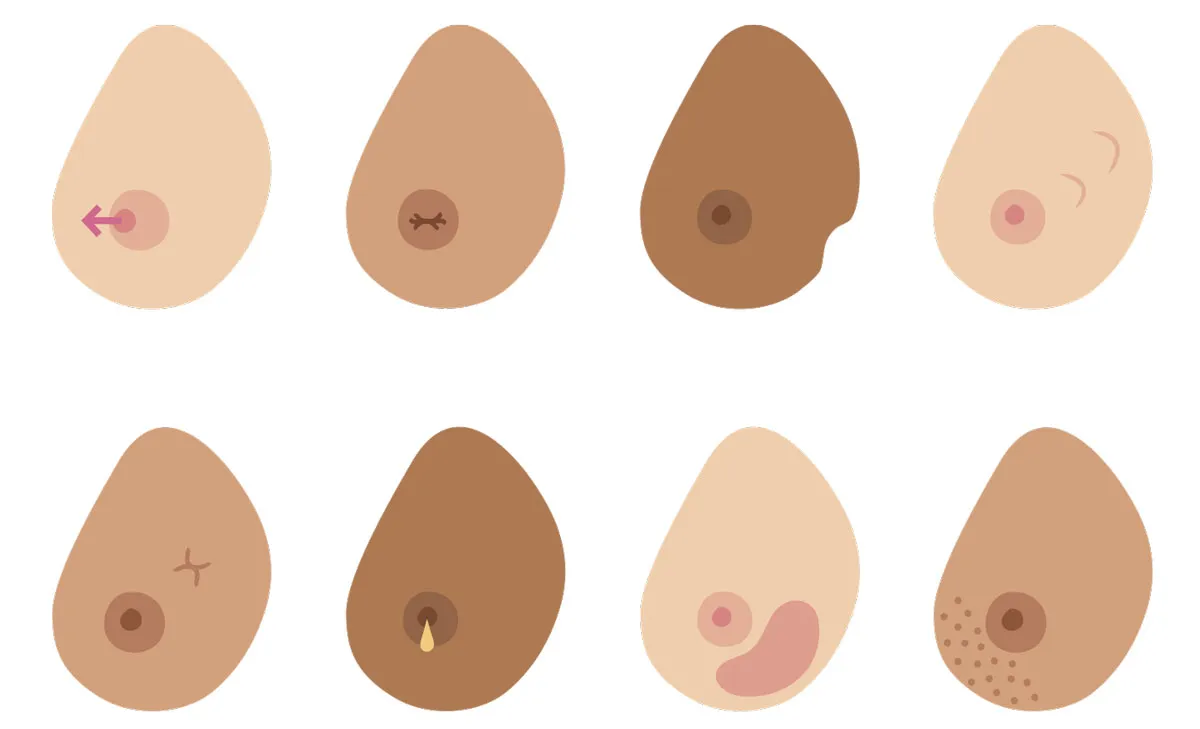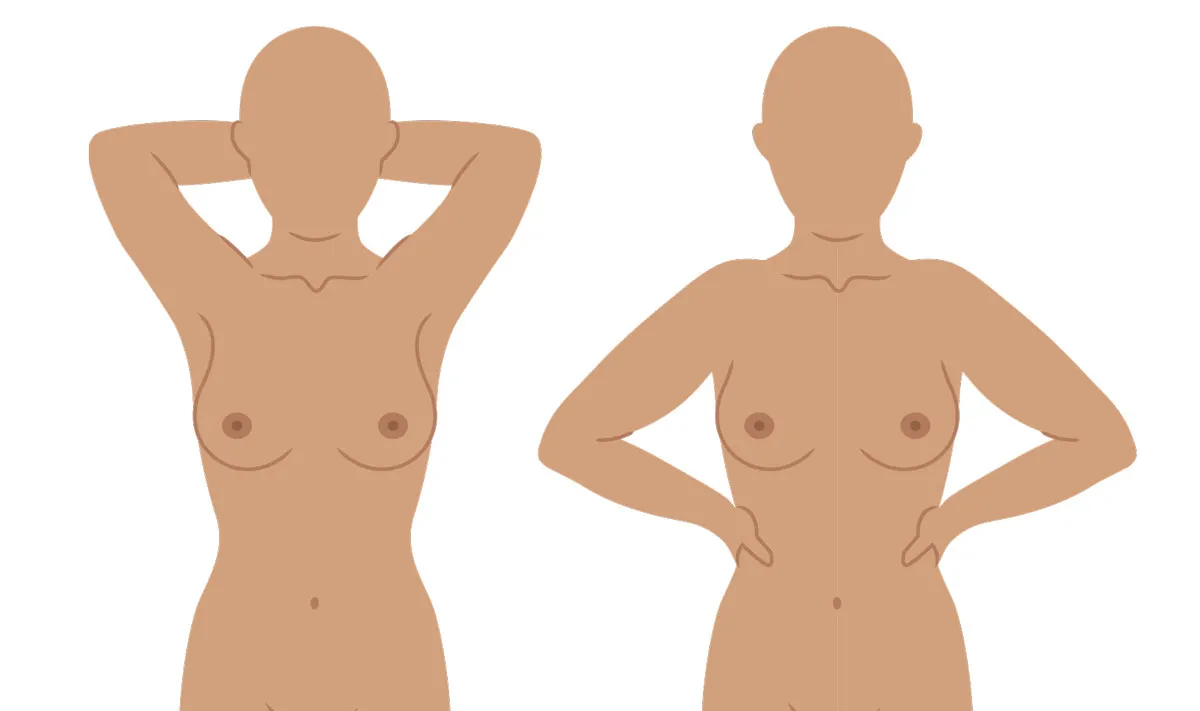Here’s the thing: not only are you unique, but your breasts are too – everyone’s breasts are different in both size and shape. And it’s completely normal for there to be differences between your breasts too: asymmetrical breasts, and having one larger than the other is also completely normal.
Your breasts, too, are likely to change in size and shape at different stages of your life – for example, if you become pregnant or are breastfeeding.
However, there may be some changes you should check in with your doctor about. You can find out below exactly what they are – and how to properly examine your breasts.
What to look out for with your breasts

- Change in nipple direction.
- Change in nipple inversion.
- Change in size, shape, or outline.
- New lumps or areas of thickening.
- Puckering or dimpling.
- Nipple discharge.
- Rashes, red or darker patches, or nipple crusting.
- Orange peel-like skin, or the appearance of cellulite.
Read more:
- Breast cancer: Early screening 'could save up to 400 lives a year'
- Instant Genius Podcast: Breasts, with Dr Philippa Kaye
How to examine your breasts
The best way of examining your breasts is using the TLC acronym: Touch, Look, and Check any changes with a doctor
Look

- Stand in front of a mirror, with your hands relaxed by your sides, and look at your breasts. Turn to one side and then the other. If you have large breasts, lift them up so that you can look underneath.
- Look for any changes to your breast size and shape, or any new asymmetry. Look for any lumps, or any changes in your breast outline.
- Look for any nipple changes. Is either nipple pointing in a different direction than normal, or has either become inverted? (Remember, only a change to the nipples needs assessment, not if you have always had inverted nipples).
- Look for any skin changes: can you see a rash; a red or pink patch; a wet-looking patch, crusting, or scaly looking skin? Is there any itching on the breast, areola or nipple? Is there any dimpling, like the surface of an orange (called “peau d’orange”).
- Is there any nipple discharge (if you aren’t breastfeeding)? It could be clear, milky or bloody.
- Look for any puckering or dimpling of the breast. This can look like an area is tethered to something underneath, causing the breast to wrinkle, dimple or pucker.
- Now raise your hands above or behind your head (like you are sunbathing) and take another look. Place your hands on your hips and push inwards – as this tenses the chest muscles and will make tethering or dimpling more obvious, and check again.
- Raise your arms and take another look at your chest with your hands on your hips, push inwards to tense your chest, and look at your breasts again from all sides.
Key points to remember:
- Examine the whole breast up to the collarbone and into the armpit.
- You can examine each quadrant in turn or feel in a circular motion starting from the nipple and working outward (or vice versa), or examine the breast in wedge-shaped sections.
- look out for any pain or discomfort.
Touch

You can check in any position that you find comfortable: standing, sitting, lying down, whatever works for you. It may be easiest to examine your breasts in the bath or shower using a wet, soapy hand.
Lying on your back slightly propped up on a pillow can help bring the breast tissue up onto the chest so you can examine it. If your breasts are large and flop outwards toward your sides, you can roll slightly towards the opposite side of the breast you are checking to bring the breast tissue onto the chest so you can examine it properly.
- Lift one hand above your head and use the other hand to examine the opposite breast. The breast tissue extends up to the collarbone and into the armpit, so it is important to examine the whole area.
- In order to ensure that you have examined the whole breast area, imagine dividing the breast into quarters and examine each in turn. Or you could imagine that each breast is like a clock and examine the wedge-shaped areas between the numbers, moving towards the centre, or nipple. Or you could move your hand in a circular motion, starting on the outside of the breast and making smaller and smaller circles until you cover the whole breast and nipple. Or, start from the inside and work your way out. It doesn’t matter how you do it, just that you do it! Ensure you examine the nipple and all the way up to the collarbone as breast tissue can extend that far up. Then examine up to, and in, the armpit as the breast tissue extends to the armpits which also contains lymph nodes.
- Use the flat of your fingers to feel the breast, searching for any changes. As you press with your hand, you are pressing the breast tissue against your chest wall so you can feel if there are any changes underneath. It will take some time to get to know your own breasts; some people describe that they feel like blancmange or jelly. There may be small lumpy areas that feel rather like a collection of frozen peas, especially around the time of your period.
- Changes could be a lump, a thickening of the breast or a bumpy area. The upper outer section of the breast is where you are most likely to find small lumps or “nodularity”. If normal to you, nodularity is usually felt in both breasts. If it is felt in one breast alone, or is a change for you, it should be checked by your doctor.
- Any discomfort or tenderness should also be assessed, especially if it is new or only affects one breast (pain is a rarer symptom of breast cancer than other symptoms).
Check with a doctor
If you notice any changes to your breasts, get checked by your doctor. This doesn’t necessarily mean that you have cancer – it simply means that you have noticed a change that needs to be checked.
How to examine your breasts after breast cancer surgery
It’s important to get to know what is normal for your chest after surgeries like lumpectomy or mastectomy. Local recurrence of breast cancer can happen, depending on the type of breast cancer you have.
This may range from about 2 to 12 in every 100 breast-cancer patients. Examine your chest as described in this chapter, first looking in the mirror and then feeling with your hand. In particular, look and feel for any lumps close to your scar. Are there any skin changes like a small ulcer or a rash? Your scar may extend to your side so be sure to check the whole area.
Read more:
- Breast cancer: Artificial intelligence boosts accuracy of tumour diagnoses
- Compound found in human breast milk has the potential to fight cancer
- Early-stage breast cancers 'more than doubles' risk of invasive breast cancer death later in life
Extracted from Breasts: An Owner's Guide by Dr Philippa Kaye, out now (£15, DK)
- Buy now from Amazon UK and Bookshop.org

